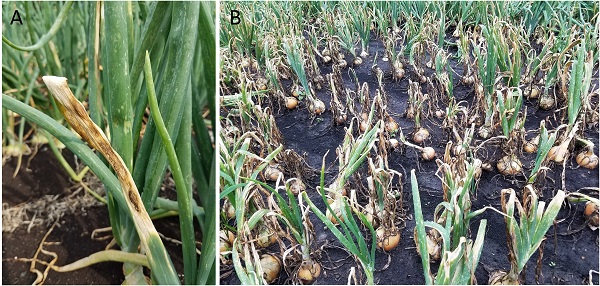New York is the fifth largest producer of onion bulbs in the United States, producing over 110,000 metric tons from over 2,800 hectares. Most of these onions are grown on high organic matter soils, where foliar disease management is crucial to productivity and profitability. These foliar diseases include Botrytis leaf blight, purple blotch, downy mildew, and Stemphylium leaf blight.
Stemphylium leaf blight (SLB) initially appears as small, tan to brown lesions that coalesce and extend the length of the leaves. These lesions become dark olive brown to black, contributing to the loss of green leaf area, which may affect bulb size and quality and prevents the plant tops from lodging naturally when the bulbs are fully matured.

A, Stemphylium leaf blight (SLB) lesion on an onion leaf. B, An SLB disease focus in a commercial onion field in New York.
Until recently, SLB has been considered a minor foliar disease as it has not done much damage in New York since the early 1990s. However, onion growers in New York have recently seen an increase in the dieback of their crops, and scientists at Cornell University were surprised to discover that SLB was the cause.
“We set out to determine the cause of the dieback problem,” said Frank Hay, one of the Cornell University scientists. “A surprise was that Stemphylium leaf blight had long been considered a minor disease of onion but had become the dominant foliar disease in New York onion crops.”
Hay and his colleagues discovered that the re-emergence of SLB occurred as the disease developed resistance to fungicides. Their research has resulted in the removal of some fungicides from commercial production as widespread field resistance has developed.
